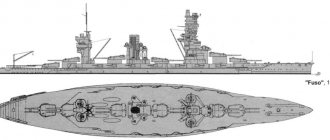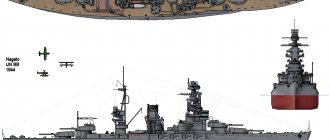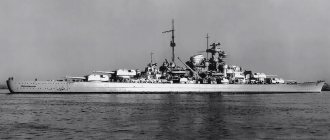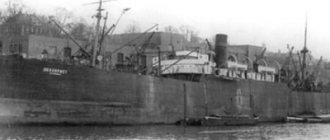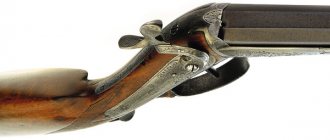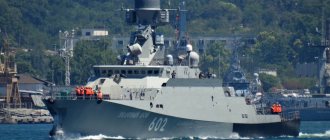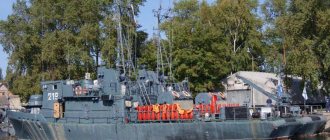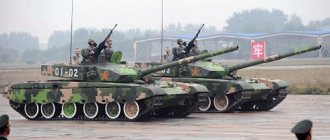The cruiser of the USSR Navy "October Revolution" was built according to project 68-bis, almost immediately after the Great Patriotic War and entered service in 1954. It should be noted that just over 2 years passed from the moment of laying the plant at the shipyard of plant 402 in Molotovsk (today’s name Severodvinsk) until the completion of all tests and transfer to the fleet, which sharply contrasts with the state of affairs in the modern shipbuilding industry. The photo below shows Molotovsk in the early 50s.
Cruiser name
The cruiser "October Revolution" belonged to the type of light cruisers and at first, until 1957, was called "Molotovsk", in honor of the city where it was built, and only then was renamed. The anthem of this warship mentions that it is the heir to the legendary battleship of the same name, which took an active part in the defense of Leningrad, and Petty Officer Ivan Tombasov , who accomplished a feat and saved the battleship from destruction during hostilities, was forever enlisted in the personnel of the cruiser under number one.
Commanders
- 1911-06/03/1915 - captain 1st rank Grigorov, Nikolai Mitrofanovich
- 1915-28.06.1916 - captain 1st rank Kedrov, Mikhail Alexandrovich
- 1916-1917 - captain 1st rank Paletsky, Pyotr Petrovich
- 1918-1921 - Antonov, Lev Viktorovich
- 1921-1922 - Viktorov, Mikhail Vladimirovich
- 1925-1928 - Salmin, Evgeniy Ivanovich
- 1928-1930 - Ivanov, Vadim Ivanovich
- 1930-1936 - Nesvitsky, Nikolai Nikolaevich
- 1936-1939 - Ptokhov, Boris Pavlovich
- 1939-1940 - captain 2nd rank Vdovichenko, Dmitry Danilovich
- 1940-1942 - Rear Admiral Moskalenko, Mikhail Zakharovich
- 1942-1945 - captain 2nd rank Petrishchev, Nikolai Andreevich
- 1945-1946 - Soloukhin, Sergei Dmitrievich
- 1947-1951 - Narykov, Vasily Maksimovich
Battleship "October Revolution"
It was built before the revolution, during the period of restoration of the Russian navy after the defeat at Tsushima in the Russo-Japanese War. By the way, the cruiser Aurora, a symbol of the October Revolution, also took part in this battle.
The battleship was named "Gangut" in honor of the first victory of the Russian regular fleet under the leadership of Peter the Great over the Swedish squadron in 1714 in the area of Cape Gangut on the Hakko Peninsula (present-day Finland).
During the Second World War, the battleship, renamed the "October Revolution", made a significant contribution to the defense of Leningrad with the fire of its large-caliber guns. Most of its crew took a direct part in the battles on the outskirts of the city. The battleship was subjected to numerous bombings, and was even partially sunk, but did not stop firing at the enemy. The numerous sacrifices and persistent heroic struggle of the ship and its crew were repeatedly awarded with awards and honorary titles.
History[ | ]
She was laid down on June 3 () 1909 at the Admiralty Shipyard on the same day as the battleship Poltava of the same type. Builder - L. L. Coromaldi. On October 7, 1911, it was launched, completed, passed sea and acceptance tests, at the end of December it was enlisted in the active fleet, moved to Helsingfors, where it was included in the 1st brigade of battleships of the Baltic Fleet.
Took part in the First World War. On November 11, 1915, the battleships Gangut and Petropavlovsk, under the cover of cruisers of the 1st Brigade, laid a minefield of 550 mines south of the island of Gotland. On November 25, the German cruiser Danzig was blown up by mines at this barrier. Having made three military campaigns in the second half of 1915 to ensure mine laying in the Baltic Sea, the Gangut remained in Helsingfors for the rest of the First World War.
On October 19, 1915, on the Gangut stationed at the Helsingfors roadstead, there was an indignation among the lower ranks of the crew. In the evening, the sailors refused dinner, and then demanded that senior officer Baron E. E. Fittinghof be removed from the ship. While attempting to seize the weapons, they were stopped by officers. The commander of the Gangut, Captain 1st Rank A. Kedrov, had difficulty keeping the sailors from speaking out, promising to look into their demands, the main ones being improved food and the expulsion of officers of German origin from the ship. On October 20, the commander of the Baltic Fleet, Admiral Kanin, arrived on the Gangut. An investigation began, the work of the investigative commission was headed by Admiral A. Nebolsin. A total of 95 sailors were arrested (among them was the famous future communist Dybenko), 34 of them were brought to trial. 26 sailors were sentenced to hard labor for a term of 4 to 15 years, 8 sailors were acquitted by the court.
"Gangut" during completion
Launching of the battleship "Gangut"
The indignation of ordinary sailors was a reaction to the passivity of the mighty ship in wartime conditions. Prior to this, the officers, languishing from idleness, allowed excessive suspicion and unfounded fault-finding towards the rank and file with a clearly expressed political motivation to identify unreliable sailors. Representatives of various political parties carried out propaganda on the ship, distributing leaflets in which, in particular, it was reported that the newest battleships were idle under the influence of naval officers of German origin. In conditions of inaction during wartime, emotional and psychological tension increased in the relationship between the command and rank and file of the ship. After performing the physically difficult emergency work of loading coal onto the ship, instead of traditionally relying on pasta with meat (“naval pasta”), the rank and file were offered barley porridge. The sailors' reaction was lightning fast. The question arose: who ordered to cook porridge instead of pasta in the navy? The situation was clearly provoked. It is also unclear what Admiral Nebolsin was thinking about when placing emphasis on the results of the work of the investigative commission; Only one thing is clear: these accents were placed incorrectly, at least from a psychological point of view.
From March 12 to March 17, 1918, as part of the first detachment of ships, he made an ice crossing from Helsingfors to Kronstadt.
In November 1918 it was transferred to Petrograd, where, after conservation, it remained in long-term storage near the wall of the Leningrad plant until May 1925.
At the end of 1924, restoration work began.
On April 18, 1925, the battleship Gangut was enrolled in the training detachment of the Naval Forces of the Baltic Sea.
On April 26, 1925, repairs of the ship continued at the Kronstadt Steamship Plant.
On May 15, 1925, the USSR naval flag and flag were raised for the first time on the battleship Gangut.
Renamed "October Revolution" on June 27.
B - underwent another repair and modernization at the Baltic Shipyard.
|
During the Soviet-Finnish War, in December 1939, the battleships "October Revolution" and "Marat" fired at Finnish heavy coastal batteries located on islands near Vyborg. The destroyer Lenin guarded the battleships from the Gulf of Finland.
During the Great Patriotic War, it took part in the defense of Leningrad and was damaged by German artillery fire and aircraft. The commander of the ship in 1941-42 was M. Moskalenko. The battleship was awarded the Order of the Red Banner.
After July she was used as a training ship. Expelled from the Navy in 1956. Anchors and an anti-aircraft gun (Ivan Tombasov's gun), removed from the battleship, are installed on Anchor Square in Kronstadt.
In 1973, the USSR issued a postage stamp and a maximum card with an image of a battleship.
Ship design and its tasks
In total, 14 military ships of the Project 68-bis light cruiser class were built at the shipyards of the Soviet Union, which included the cruiser "October Revolution". These warships were the last artillery ships in history, the main armament of which was 152 mm guns, located in four turrets of three guns each.
Initially, the main task of these light cruisers was to confront the fleets of a potential enemy in order to inflict sufficient damage on him and create obstacles to an attack on the territory of the USSR and its allies. Why were special task forces created with the participation of these ships that carried out combat duty in areas where NATO warships were concentrated?
However, with the advent of a new era, when various guided missile systems became the main weapons, the tasks for these vessels changed. Now the main thing was to provide amphibious landings, as well as support for its ground forces during combat operations under the cover of coastal aviation. In addition, the duties of these cruisers also included the task of so-called flag demonstration.
The very appearance of the warship made an exceptionally strong impression. Fortunately, in the entire history of its existence, the cruiser (Project 68) never fired a single shot towards the enemy, but it fulfilled its task of preventing conflicts perfectly.
Reference materials
History of changes
- Available to supertesters in the game starting from version 0.6.7.
- First appeared in July 2022.
- In update 0.6.9
improved ship geometry.:
- In update 0.6.12: the parameter “Visibility when firing a main gun in smoke” has been changed to 10.47 km;
- minor visual defects in geometry and textures have been fixed;
- the ship became available for purchase in the game client.
Improved display of thin elements.
:
Permanent camouflages “Type 9” and “Red October” have received a bonus - a 10% discount on the cost of maintenance after the battle.
:
Fixed ship geometry and textures. These changes do not affect the game characteristics of ships.
:
Minor corrections have been made to the geometry and textures of the ship and camouflage.
:
became available in the game client for purchase with doubloons.
:
Geometry and texture corrections have been made.
:
minor geometry and texture fixes.
:
The date of entry into service has been corrected in the description.
:
minor fixes to textures and ship models.
it was changed:
Historical information about the October Revolution
"October Revolution"
- battleship of the USSR Navy of the Sevastopol type.
Built in the Russian Empire under the name “Gangut”, in 1925 it was renamed “October Revolution”. Participated in the Soviet-Finnish War and the Great Patriotic War. After the war, she was reclassified as a training battleship, and in 1956-1957 she was expelled from the fleet and cut up for metal. Read completely…
Cruiser characteristics
The cruiser "October Revolution" was built according to the 68-bis project; in maritime circles, ships of this series were affectionately called "imps", according to NATO classification - "Sverdlov". The ship's hull is completely welded using homogeneous armor, but with old power plants and insufficient anti-aircraft weapons, which was noted by all experts.
The length of the ship was 210 meters, the width was 22 meters, and the area was more than half the size of a football field. The total displacement is 16,340 tons, and such a colossus could reach a maximum speed of 33 knots, or more than 60 km/h. Crew – 1270 people. In addition to the already mentioned main caliber guns, 12 100 mm guns, as well as 30 mm machine guns, were installed on board. In terms of firepower, it was a very serious weapon. A photo of the cruiser "October Revolution" in Baltiysk is presented below.
Modules
| HP | Main caliber towers (pcs.) | Auxiliary caliber towers (pcs.) | Air defense points (pcs.) | Torpedo tubes (pcs.) | Hangar capacity (pcs.) | (experience) | () |
| Gangut (A) | 37 600 | 4 | 16 | 8 | 128 000 | ||
| Gangut (B) | 40 500 | 4 | 16 | 4 | 2000 | 280 000 |
| Maximum travel speed (knots) | (experience) | () |
| Power plant 42,000 hp | 23 | 30 000 |
| Increase in firing range(%) | Maximum firing range(km) | (experience) | () | |
| OMS IV mod. 1 | 12,4 | 40 000 | ||
| OMS IV mod. 2 | 10 | 13,7 | 1300 | 180 000 |
| Rate of fire (rounds/min) | Rotation time 180°(s) | Maximum dispersion(m) | Maximum HE projectile damage (HP) | Probability of arson when hitting a target with a HE projectile (%) | Maximum AP projectile damage (HP) | (experience) | () |
| 305 mm/52 mod. 1907 | 1,7 | 56,25 | 180 | 4500 | 33 | 8600 | 94 000 |
Combat service
The cruiser "October Revolution", then still "Molotovsk", began the first years of its history as part of the Northern Fleet and almost immediately, together with other ships, took part in testing nuclear weapons on the island of Novaya Zemlya. The details of this event still remain classified, but the fact itself is remarkable.
In 1956, the ship made calls to the ports of Oslo and Gothenburg. After its renaming there were more courtesy visits to Bergen and Copenhagen. In 1960, the ship was transferred from the Northern Fleet to the Baltic. All this coincided with the reorganization of the country's Armed Forces, begun by General Secretary N. S. Khrushchev, who, as is known, had a special passion for missiles. These reforms had a sad effect on the fate of the artillery cruiser “October Revolution” in Baltiysk (there are no photos from those times, unfortunately).
Three months after being transferred to the Baltic Fleet, the ship was withdrawn from combat service in the USSR Navy and transferred to Kronstadt, where it was mothballed. The cruiser spent a long 5 years in this captivity until it was reactivated in 1966 and almost immediately sent for modernization to a plant in Sevastopol, where the cruiser was upgraded to the level of a flagship ship of the landing forces in accordance with the new concept of its possible use.
The project received the name 68-a, and according to it, in addition to the cruiser “October Revolution”, 3 more of the same cruisers were redesigned: “Alexander Suvorov”, “Mikhail Kutuzov” and “Admiral Ushakov”. The ship received a number of new radio-electronic communication and control systems, as well as 8 AK-230 rapid-fire mounts. Subsequently, in addition to the “flag demonstration” in Cherbourg, Gdynia, Copenhagen and Rostock in the 70s, the cruiser “October Revolution” performed real combat missions.
He was almost constantly on combat duty, accompanying the ships of the US 6th Fleet. In addition, twice (in 1970–1972) the ship participated in hostilities, providing assistance in the Arab-Israeli conflicts in the Mediterranean Sea, first off the coast of Syria and then off Egypt. The goal was to prevent US interference in these confrontations.
Everything was very serious, the ship’s command received the task of being fully prepared to destroy the American task force in these areas. Fortunately, everything worked out fine. There is practically no information about this in the public domain, but tension was extremely high.
About parents
| My father is Alexey Grigorievich Proshchenko, originally from the Bryansk region - Suzemsky district, Denisovka village. Born March 14, 1918. In the 1930s, during the famine, almost the entire family moved to Ukraine. There he worked as a tractor driver and plowed the land. From there, in '39, he was called up to serve in the navy. He served and fought throughout the war on the battleship "October Revolution" as a turret gunner of the main caliber gun, in the 1st tower. Demobilized in 1946. He entered the factory as a mechanic. In the evenings I studied at evening school. After graduating, I entered college, but was forced to quit. He was a highly qualified mechanic - 6th category, worked on Uralskaya Street. Died in October 2000. Mother, Proshchenko (Vasilieva) Nadezhda Nikolaevna, was born on October 13, 1922 in the Pskov region, in the village of Kriukhi, Pustoshkinsky district. I know less about her. I know that she lived in Leningrad throughout the blockade, worked at the Kalinin plant, and dug trenches on the outskirts of the city. In 1946, my mother and father got married, and in 1949 I was born. It was then that my father dropped out of college. We lived on Vasilyevsky Island, on the 8th line in an 11-meter room. Mom died two months after father. | |||
| A. Proshchenko - during his years of service in the navy, 1939-46 | |||
| Award lists of A.G. Proshchenko | |||
| Memories of my father - in the book “Volleys from the Neva” THIS IS HOW THE BATTLESHIP COMMANDORS FOUGHT "OCTOBER REVOLUTION" The war found the battleship "October Revolution" in the main naval base of the Red Banner Baltic Fleet - Tallinn. The situation on the land front was developing in such a way that the battleship's further stay in the Tallinn roadstead was unjustified. At the beginning of July, the battleship was relocated to Kronstadt and joined the unified defense system of Leningrad. Other authors will talk about the military affairs of the “October Revolution” in September 1941. I can only say that the battleship carried out all the command’s combat missions with honor and inflicted significant blows on the advancing enemy troops. | |||
| Father and Mother Awards | |||
| Battleships of the Baltic Fleet | |||
| Battleship "October Revolution" Laid down on June 16, 1909 at the Admiralty Shipyard. Launched on September 24, 1911 under the name "Gangut". Renamed “October Revolution” on June 27, 1925. Withdrawn from the fleet in 1956. Displacement 26,900 tons (full), length 184.9 m, beam 26.9 m, draft 9.1 m. The main caliber armament is 12 305 mm guns in 4 turrets. The weight of the projectile is 491 kg, the firing range is up to 30 km. | |||
| 1934 | 1944 | after the war | |
| Battleship "Marat" Laid down on June 15, 1909 at the Baltic Shipyard. Launched on August 27, 1911 under the name "Petropavlovsk". 03/31/1921 - renamed “Marat”. 05/31/1943 - the name “Petropavlovsk” was returned. 1950 - reclassified into a non-self-propelled artillery training vessel under the name "Volkhov". 1953 - dismantled for metal. | |||
| 1939 | Gdynia (Poland, 1934) | Spithead (England, '37) | Coin of Mr. Palau |
"October Revolution":
21 Sep. three aerial bombs from 100 to 250 kg. they tore up the forecastle (seen in the left photo). 23 Sep. two 250 kg aerial bombs hit the 3rd tower and the deck near it. On the right is a diagram of air bomb drops on September 21, 22 and 23. At the end of September, the battleship arrived at the Baltic Shipyard under its own power for repairs. From there, he continued firing with the main caliber at the fascist positions near Leningrad "Marat": on the 23rd at 11:00, one or two 1000 kg aerial bombs, breaking through the deck, exploded in the artillery magazine - the entire bow of the ship with the foremast and the first tower was destroyed. 326 people died immediately. “Marat” sank to the bottom. After some time, he was brought into combat readiness as best he could and he continued firing with the three remaining main-caliber turrets.Mauritius
In the book “Cruisers of the Sverdlov class” by A. Shirokorad, the participation of the cruiser “October Revolution”, or rather its crew, in providing assistance to the state of Mauritius in 1974 is mentioned. There was a strong tropical hurricane that caused enormous damage to this island state, which gained independence from Great Britain. For two weeks, the cruiser's crew participated in work to restore destroyed power lines, telephone lines and clear debris.
Shipbuilding programs
Two small programs were developed, according to which it was planned to build new ships for the Baltic and Black Sea fleets in a short time. For the Baltic it was necessary to construct 4 ships, including the battleship Gangut, 3 submarines and a mother ship to service them.
For the Black Sea Fleet, 14 destroyers and 3 submarines were to be built. Turkey, seeing the situation in the Black Sea, decides to urgently buy 3 new battleships from England and Brazil. Therefore, changes are being made and it is planned to urgently build three similar ships of the “Empress Maria” type, 9 destroyers and 6 “Bars” type submarines.
By the World War of 1914, none of the programs had been completed, moreover, not a single ship was launched.
End of service
The submarine cruiser "Kursk" and "October Revolution" were created at the same shipyard. But if the death of the Kursk had a serious resonance, the cutting of the artillery cruiser into “needles” went almost unnoticed. In September 1987, after more than 30 years of service, the cruiser "October Revolution" was disarmed and expelled from the USSR Navy for the second and last time. A year later, its cutting began at the Glavvtorchermet base in Leningrad.
The dismantling of the ship was associated with a scandal caused by a complaint by an Indian businessman with an English passport, Keshava Bhagata. He claimed that he had purchased this cruiser for cutting in India, but then the deal did not go through, although he had allegedly already paid the money.
Whether this is true or not, the end of the cruiser, a symbol of the October Revolution, was symbolic in itself. He ended his life simultaneously with the end of recognition of the world-historical significance of the revolution in official propaganda, without ever falling into the hands of an Englishman, even if not an Anglo-Saxon.
Model
Like all previous models of the “Sevastopol” series, this model was also built from scratch. And in the same way, the basis was taken from scans of a paper model of the battleship “Paris Commune” in 200 scale, which are freely available on the Internet and translated into my favorite 350 scale. The following literature was used during the construction of the model:
- “The main caliber of battleships”, L. Amirkhanov, S. Titushkin, ed. "Gangut";
- “Dreadnoughts of the Baltic”, I. Tsvetkov, D. Bazhanov, ed. "ISTFLOT";
- "Stalins Dickschiffe", Marine-Arsenal Sp 04, Siegfried Breyer;
- magazine “Modelist Constructor”, No. 11 for 1987;
- “Rosyjskie pancerniki typu Sevastopol”, Maciej S. Sobanski;
- magazines "Gangut" No. 28, 30 and 33;
- …. and a lot of other literature, those who are interested will be able to find the materials necessary for the work themselves.
A fairly large number of photographs of the battleship during different years of its service helped a lot during construction.
Publishing house "Gangut". Series of monographs “Midship frame”
Ships, like people, have their own destiny. For some it is a long life, full of victories and glory. The latter are hard workers who do their work conscientiously. Still others are those who have a short but bright life. For those who are interested in the history of the fleet, ships, their fate and features, the Gangut publishing house publishes a series of monographs called “Midship Frame”, each issue of which is dedicated to one or a series of ships with drawings for modeling attached. Including the publication prepared by the publishing house "Gangut" - "Midship frame", "Battleship "Empress Maria" - drawings."
The battlecruiser Gangut, unlike the battleship Empress Maria, is an honored veteran who went through two world wars. About his interesting life, about the people who brought glory to the ship, in the Gangut publishing house, in the series of monographs “Midship frame” there is a number dedicated to the battleship “Gangut”. The drawings will help specialists independently complete the model and read interesting information about the ship and the lives of the people for whom the ship was a home and place of service. Creating a ship with your own hands - what could be more interesting? A model of the battleship "Gangut" on a scale of 1:350 is presented.
